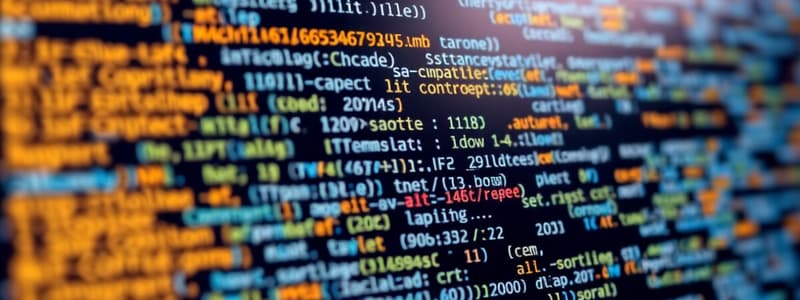Podcast
Questions and Answers
What is the primary characteristic of machine language?
What is the primary characteristic of machine language?
- It uses high-level abstractions and keywords.
- It is the only language that a computer can directly work with. (correct)
- It requires extensive documentation.
- It is easily understandable by humans.
Which statement about assembly language is true?
Which statement about assembly language is true?
- It is identical to machine language.
- It does not require operands for instructions.
- It uses mnemonics to represent low-level instructions. (correct)
- It is a high-level programming language.
C programming language is known for which main characteristic?
C programming language is known for which main characteristic?
- It emphasizes graphical user interface design.
- It is machine-independent and creates a variety of applications. (correct)
- It is tied to specific hardware.
- It is mainly used for web development.
Which programming language is classified as high-level and emphasizes code readability?
Which programming language is classified as high-level and emphasizes code readability?
What best describes the purpose of coding?
What best describes the purpose of coding?
What is described as the task of teaching a computer your way of solving a problem?
What is described as the task of teaching a computer your way of solving a problem?
What type of error is characterized by assigning the same statement number to two instructions?
What type of error is characterized by assigning the same statement number to two instructions?
Which of the following is NOT a function of the Menu Bar in the C++ Integrated Development Environment?
Which of the following is NOT a function of the Menu Bar in the C++ Integrated Development Environment?
In programming, what is the term for the instructions written by a programmer?
In programming, what is the term for the instructions written by a programmer?
What does the Status Area in the C++ IDE display?
What does the Status Area in the C++ IDE display?
Which of the following best describes a flowchart in the context of programming?
Which of the following best describes a flowchart in the context of programming?
What is the purpose of identifiers in programming?
What is the purpose of identifiers in programming?
What window in the C++ IDE displays compiler or linker messages?
What window in the C++ IDE displays compiler or linker messages?
Flashcards are hidden until you start studying
Study Notes
Programming Languages
- Machine Language: The fundamental language directly understood by computers, consisting of binary code that is difficult for humans to read.
- Assembly Language: Uses mnemonics to represent machine instructions; allows for easier program writing but still closely tied to machine language.
- Middle-Level Language: Combines features of high-level and low-level languages; assembly language serves as a notable example, utilizing mnemonics for commands.
- C Programming Language: Machine-independent language commonly used for developing operating systems and applications including Windows, Oracle, and various others.
- Java: A high-level, class-based, object-oriented language known for its portability across platforms with minimal implementation dependencies.
- Python: A high-level, general-purpose language noted for its readability and the use of indentation for block structures.
- JavaScript (JS): A lightweight, interpreted programming language that supports first-class functions and is widely used for web development.
- C++: An object-oriented language enhancing the efficiency of code structure and reusability, reducing overall development costs.
- Swift: Developed by Apple Inc., this high-level, multi-paradigm language is designed for general-purpose programming.
Programming Concepts
- Coding: The process of translating design into functioning programs through writing code in a programming language.
- Programming: Involves defining the design to a computer and articulating methods for problem-solving.
- Data: Refers to collections of values or symbols conveying information that can be discrete or continuous.
- Compilation: The process of converting programming language code into machine-level instructions composed of binary code (0s and 1s).
- Debugging: Involves examining code for errors, fixing those issues, and recompiling to ensure functionality.
- Code: Refers to the set of instructions written in a programming language, known often as source code.
- Keywords: Reserved identifiers in programming languages with fixed meanings that cannot be reused as variable names.
- Identifiers: Comprises letters, digits, and special characters to create variable names in code.
Types of Errors in Programming
- Clerical Error: Mistakes like assigning identical statement numbers to different instructions.
- Logical Error: Errors due to missing crucial information, such as omitting important factors in a payroll system.
Programming Tools
- Decision Table: A structured format presenting complex conditions and associated actions.
- Flowchart: A visual representation that outlines the sequence of operations in a program.
C++ Integrated Development Environment (IDE)
- Menu Bar: Located at the top, displays dropdown menus for various options.
- Close Box: Upper left corner feature used to close the current window.
- Title Bar: Displays the name of the active window, situated below the menu bar.
- Desktop/Editor: Central area for arranging various windows for programming tasks.
- Frame: Provides a border for the window interface.
- Resize Corner: Allows the user to adjust the size of the active window.
- Message Compiler Window: Positioned beneath the editor, it shows compiler or linker messages.
- Status Area: Found at the bottom, it contains shortcut keys and offers assistance to users.
- Window Number: Identifies the specific window currently in use within the IDE.
Studying That Suits You
Use AI to generate personalized quizzes and flashcards to suit your learning preferences.




